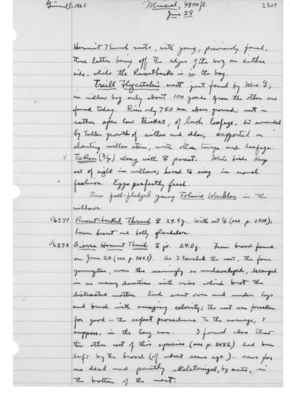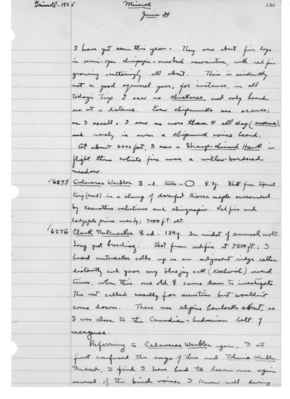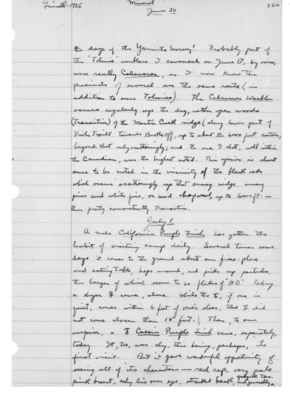Pages That Mention MacGillivray's Warbler
1925: Joseph Grinnell's field notes
S2 Page 39
Collector: Grinnell - 1925 Location: Mineral Date: June 23 Page Number: 2493
Mt. Chickadee (2); Western Tanager (5); Fox Sparrow (2); Chipping Sparrow (18); Hermit Warbler (3); Tolmie Warbler (1); Calaveras Warbler (1); Warbling Vireo (8); Calif. Purple Finch (4); Wood Pewee (13); Lazuli Bunting (3) Pileated Warbler (1); Spotted Sandpiper (2, along sparsely pebbled margins of creek); Traill Flycatcher (1); Yellow Warbler (2); Robin (29+, one seen carrying mud up to nest 50 feet above and on lowermost branch of huge yellow pine); Cassin Vireo (1); Audubon Warbler (7); Blue-fronted Jay (1); Turkey Vulture (2, one circling above vicinity of store (?), and one above woods at this end of the meadow) Brewer Blackbird (1, [female symbol] bathing and preening, as if just off nest); Pine Siskin (1); Ruby-crowned Kinglet (2); Canada Nuthatch (1); Crossbill (1, loud "chup" note heard from tips of yellow pine, given persistently, until bird flew, and also then); Killdeer (2); Meadowlark (2); Sierra Creeper (1); Western Bluebird (2); Western Lark Sparrow (1, [male symbol] singing volubly from well up in yellow pine at edge of meadow); Wright Flycatcher (2); Olive-sided Flycatcher (1); Solitaire (1); Pygmy Nuthatch (2, in different places, in upper parts of large yellow pines); White-headed Woodpecker (2); Modoc Hairy Woodpecker (2); Red-winged Blackbird (1+, heard from willows along stream, far out in meadows); Cassin Purple Finch (2, mating pair).
Total, for 1 1/2 hrs., 8:15-9:45: 38 species, 133 individuals.
1 p.m. Still at west end of Battle Creek Meadows. Have heard a Black-headed Grosbeak singing, and a Red-shafted Flicker. Just saw a Black-tailed Jack Rabbit (Lepus c. californicus) lope up the hill thru the snow bushes, from
S2 Page 56
Collector: Grinnell - 1925 Location: Mineral, 4800 ft. Date: June 29 Page Number: 2509
Hermit Thrush nests, with young, previously found, these latter being off the edges of the bog on either side, while the Russet-backs is [sic] in the bog.
Traill Flycatcher's nest just found by Mrs. G.; in willow bog only about 100 yards from the other one found today. Rim only 750 mm. above ground; nest in rather open low thicket, of lush leafage, but surrounded by taller growth of willow and alder; supported on slanting willow stem, with other twigs and leafage. Taken (3/4) along with [female symbol] parent. Male birds keep out of sight in willows; heard to sing in usual fashion. Eggs perfectly fresh.
Saw full fledged young Tolmie Warbler in the willows.
6271 Russet-backed Thrush [female symbol] 29.5 g. With set 1/4 (see p. 2508);
6272 Sierra Hermit Thrush [male symbol] ju. 24.0 g. From brood found on June 20 (see p. 2463). As I touched the nest, the four youngsters, even tho seemingly so undeveloped, decamped in as many directions with cries which brot [sic] the distracted mother. Each went over and under logs and bush with amazing celerity; the nest was forsaken for good - the safest procedure to the average, I suppose, in the long run. I found also that the other nest of this species (see p. 2482) had been left by the brood (of about same age) - save for one dead and partly skeletonized, by ants, in the bottom of the nest.
S2 Page 58
Collector: Grinnell - 1925 Location: Mineral Date: June 30 Page Number: 2511
I have yet seen this year. They were about fir logs in semi-open chinquapin-snowbush association, with red fir growing scatteringly all about. This is evidently not a good squirrel year; for instance, in all today's trip I saw no chickaree, and only heard one at a distance. Even chipmunks are scarce; as I recall, I saw no more than 4 all day (amoenus), and rarely is even a chipmunk voice heard.
At about 6000 feet, I saw a Sharp-shinned Hawk in flight thru the white firs near a willow-bordered meadow.
6275 Calaveras Warbler [male symbol] ad. testes - [testes illustration] 8.3 g, Shot from topmost twig (dead) in a clump of dwarfed Sierra maple surrounded by ceanothus velutinus and chinquapin. Red firs and lodgepole pine nearby; 7000 ft. alt.
6276 Clark Nutcracker [female symbol] ad. 134 g. In midst of annual molt. Long past breeding. Shot from red fir at 7500 ft.: I heard nutcracker calls up on an adjacent ridge rather distantly and gave my bluejay call (Kochwish) several times, when this one old [female symbol] came down to investigate. The rest called nasally for sometime but wouldn't come down. There were alpine hemlocks about, so I was close to the Canadian-hudsonian belt of mergence.
Referring to the Calaveras Warbler again, I at first confused the songs of this and Tolmie Warbler. Indeed, I find I have had to learn over again several of the bird voices I knew well during
S2 Page 59
Collector: Grinnell - 1925 Location: Mineral Date: June 30 Page Number: 2512
the days of the Yosemite Survey! Probably part of the "Tolmie" warblers I censused on June 17, by voice, were really Calaveras, as I now know the precincts of several over the same route (in addition to some Tolmies). The Calaveras Warbler occurs regular up the dry, rather open woods (Transition) of the Martin Creek ridge (along lower part of Viola Traill towards Brokeoff, up to about the 6000 foot contour; beyond that only scatteringly; and the one I shot, well within the Canadian, was the highest noted. This species is almost sure to be noted in the vicinity of the black oaks which occur scatteringly up that sunny ridge, among pines and white firs, or mid chaparral, up to 6000 ft. thus pretty consistently transitional.
July 1 A male California Purple Finch has gotten the habit of visiting camp daily. Several times some days it comes to the ground about our fire-place and eating table, hops around, and picks up particles, the larger of which seem to be flakes of "H O". Today a shyer [female symbol] came, alone. While the [male symbol], if one is quiet, comes within 6 feet of one's shoes, the [female symbol] did not come closer than 15 feet. \ Then, to our surprise, a [male symbol] Cassin Purple Finch came, separately, today. It, too, was shy, this being, perhaps, its first visit. But it gave wonderful opportunity of seeing all of its characters - red cap, very pale pink breast, ashy line over eye, streaked beak, and generally ^grayish tone.
S2 Page 82
Collector: Grinnell - 1925 Location: Mineral, 4,800 ft. Date: July 28 Page Number: 2534
Heard "pe-ark" notes of Nighthawk last evening. A Green-backed Goldfinch flew over camp. Heard a Cooper Hawk calling near camp. Blue-fronted Jays are much more in evidence now than a month ago - noisier. A circuit this evening, till dusk, down along the willows and tracts of lodgepole pines left an impression of extreme quietness; nothing was singing. Juncos in two places showed worry, as if young were near by. The squeal notes of young robins were heard. A lone Wright Flycatcher gave a two-syllabled "see-pit" a few times.
July 29 Mrs. G and I went up the Viola (Martin Cr. ridge) Trail to about the 5800. foot contour, taking the accompanying 4-hour census, 8:30 - 12:30; Mrs. G. pencil-checked on card-board; results, 31 species, 134 individuals, in 4 hours - not so bad, considering the songlessness [sic] of nearly all species. The only songs heard were: Fox Sparrow (once); Warbling Vireo (2, singing rather persistently); Mountain Chickadee (both "jumbling" burble and tee-tee, too-too); Cassin Purple Finch (merely fragmentary). Only food calls, or location notes, or clean calls of all other species heard. A brood of 3 bob-tailed frowsy-headed young Tolmie Warblers in ceanothus cordulatus patch, with [female symbol] parent. Saw where a Chickaree was working in a yellow pine - ground beneath strewn with fresh green cone scales and cores; heard at least 4 chickarees.




